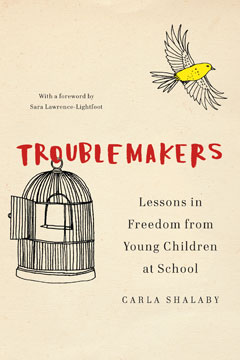Troublemakers
 As educators responsible for upwards of 20 students' academic progress, personal safety, social-emotional development, it can be easy to slip into the "good students sit still and quiet" mindset while labeling students who don't subscribe to this mold "troublemakers." However, this labeling system is detrimental to the students, educators, and the school community. Throughout Troublemakers: Lessons in Freedom from Young Children at School by Carla Shalaby, she explores the adverse effects of labeling students who routinely "act out" during class. The book follows four students: Zora, Lucas, Sean, and Marcus. She goes beyond their classroom presence to experience their home lives as she interviews their parents and sees firsthand what the foundation for each child is in order to humanize them; emphasizing that each child is more than a so-called troublemaker.
As educators responsible for upwards of 20 students' academic progress, personal safety, social-emotional development, it can be easy to slip into the "good students sit still and quiet" mindset while labeling students who don't subscribe to this mold "troublemakers." However, this labeling system is detrimental to the students, educators, and the school community. Throughout Troublemakers: Lessons in Freedom from Young Children at School by Carla Shalaby, she explores the adverse effects of labeling students who routinely "act out" during class. The book follows four students: Zora, Lucas, Sean, and Marcus. She goes beyond their classroom presence to experience their home lives as she interviews their parents and sees firsthand what the foundation for each child is in order to humanize them; emphasizing that each child is more than a so-called troublemaker.The first child we meet, Zora, is an excited, creative, energetic young girl in Mrs. Beverly's third-grade class. Zora is the only student of color in her class and is consistently called out for her distracting behavior. Whereas Mrs. Beverly views Zora as a disruptive presence, when Shalaby brings the reader into Zora's home, it is evident that Zora has an abundant amount of life and energy within her. Zora's parents constantly encourage her to express herself embracing that she may stand out amongst her peers. This chapter highlights an unfortunate reality in many American schools: an overwhelmingly white population causes students of color to stand out on top of the disproportionate number of disciplinary actions taken against students of color compared to their white counterparts. Zora has found herself in this exact situation. The reality of Zora's situation comes to light in the following chapter as Lucas, another third-grade student with similar disruptive patterns as Zora, is referred to as "quirky and humorous." Is this because he is a white, male student? Shalaby explores this perspective with Mrs. Beverly.
Defending her treatment of Zora, Mrs. Beverly points to the racialized system of reward in America claiming that she is mirroring life in the world beyond school. Shalaby highlights this when she writes, "Understanding that there are academic and economic rewards for meeting a standard of white, middle-class conformity, she cites those rewards as part of the motivation for enforcing a strict norm of behavior," (Shalaby 25). When reading this, I was disheartened. It is impossible to ignore the systematic racism in the United States despite large efforts to look beyond the oppressive structures that exist, particularly in education. While Mrs. Beverly attempts to prepare Zora for this reality, Zora's parents reflect a different perspective as they wish for Zora to be her fully authentic self.
How do our own implicit biases affect our students? Throughout Troublemakers, it is evident that children pick-up on the subtle - and sometimes inadvertent - cues we give in our everyday interactions. While explicit bias - attitudes and beliefs we have about a person or group - are conscious and easy to spot, implicit bias is more covert. Implicit bias refers to an unconscious belief or attitude we have about a person or group that informs the way we interact and make decisions. These beliefs can be difficult to catch as we are not fully aware that we have a bias toward a specific idea, person, or group until someone addresses it. As a teacher, being able to recognize our own biases without justifying them is crucial to creating a safe, equitable classroom. While it is evident that Mrs. Beverly's heart is in the right place in the sense that she wants the best for Zora, her constant reprimanding only certain students and not others brings to light potential subconscious feelings. Whether or not Mrs. Beverly truly does have a bias against Zora, the other children in her class are more apt to make their own associations with why certain students continually get in trouble while others don't.
Shalaby's intentional juxtaposition of Zora and Lucas exposes the racial disparities in the American education system. She emphasizes the importance of constantly assessing our actions and potential biases as our actions affect upwards of 20 impressionable young children each day. This is not to say that completely eradicating bias is possible, especially not overnight. Continual self-assessment is difficult but necessary work in order to create an equitable classroom. If you want to read more about the effects of labeling young children and how to achieve freedom in the classroom, consider reading the eye-opening and humanizing book Troublemakers: Lessons in Freedom from Young Children at School by Caral Shalaby.

Comments
Post a Comment